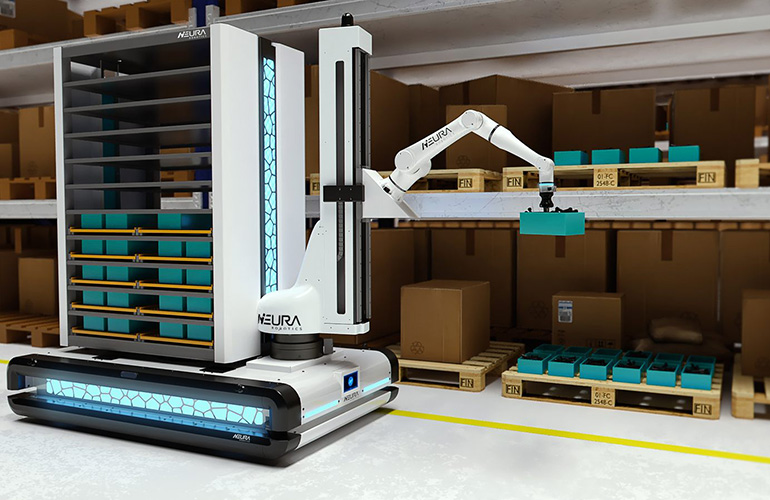|
Listen to this article  |

The workforce of Japan could use help from robots such as Neura Robotics’ lightweight agile robotic assistant (LARA), mounted on a multi-sensing autonomous vehicle (MAV) for palletizing, said the IFR. | Source: Neura Robotics
As new overtime regulations for truck drivers in Japan come into effect in 2024, the country is facing potential labor shortages and supply chain disruptions. Some call this the “2024 problem,” and the International Federation of Robotics, or IFR, claimed that automation is the solution to this problem.
In Japan, a heavy truck driver worked an average of 2,568 hours in 2022. This is 444 hours longer than the national average for all jobs, according to Labor Ministry data from 2022.
Starting on April 1, 2024, the Japanese government is limiting truck drivers’ annual overtime to 960 hours. The government said it hopes the regulations will improve working conditions for truckers and make their jobs more attractive, but it could result in a major labor shortage. If this gap is left unaddressed, a third of all cargo could go undelivered, resulting in a 10 million yen ($76 billion) hit to the Japanese economy by 2030, Reuters reported.
“The government’s overtime cap is an important step to improve working conditions for employees,” Takayuki Ito, vice president of the IFR, said in a release.
“Industrial and service robots deliver great solutions to automate,” he added. “Robots relieve workers of dirty, dull and dangerous work and help to close productivity gaps.”
 Submit your nominations for innovation awards in the 2024 RBR50 awards.
Submit your nominations for innovation awards in the 2024 RBR50 awards.
How can robots solve the ‘2024 problem’ in Japan?
Japan is the No. 1 industrial robot manufacturer in the world, according to IFR data. In 2020, Japan manufactured 45% of the global supply of industrial robots, it said.
The country is developing automation strategies that the IFR said could not only address logistical needs, but also a wide range of industry challenges the new regulations will cause.
Placing cargo in and out of trucks and warehouses is one of the most time-consuming tasks for truck drivers, making it a suitable task for automation, said the IFR. Mobile robots could save truck drivers up to 25% of working time during a day’s shift, noted the Frankfurt, Germany-based organization.
In addition, the IFR said that robots can reduce errors in order fulfillment by automating repetitive tasks such as picking and packing.
Warehousing robots could also help close the gap left by truckers working fewer hours. These can range from compact autonomous mobile robots (AMRs) to large-scale automated storage and retrieval systems (ASRS). These systems can reduce the amount of time required to move goods. They can also handle heavy loads and dangerous materials without putting human workers at risk, said the IFR.
“Regulations of overtime work and the demographic change will require the adoption of automation technology in many branches of the Japanese economy,” Ito stated. “The challenges of the trucking industry are good examples to show how robotics and automation deliver adequate solutions for our workplaces of the future.”
Service robots boom worldwide
On a global scale, more professional service robots are being built for the transportation of goods or cargo than any other function, observed the IFR. Sales grew by 44%, with more than 86,000 units sold worldwide in 2022, found the organization’s “World Robotics 2023” report.
Robot installations hit an all-time high in 2021, according to the IFR. It said that 517,385 new industrial robots were installed in 2021 in factories around the world.
Robot installations grew by 31% year over year in 2021. They exceeded the pre-pandemic record of robot installations in 2018 by 22%, the IFR said. The stock of operational robots around the world also hit a new record of about 3.5 million units.
Credit: Source link


Comments are closed.